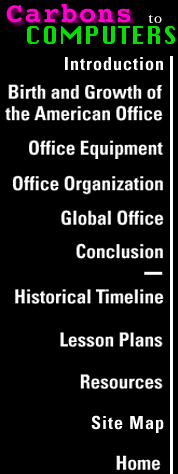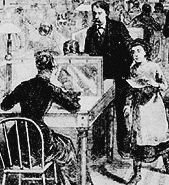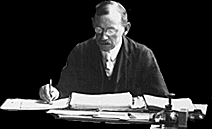
Management
Workers today take for granted the structuring of authority
in the workplace. "Boss," "supervisor," "overseer,"
and "manager" are seen as interchangeable terms. We may think
there were always bosses, certainly before the coming of the railroad. But
for the purposes of this project, it is important to see the manager
as a historical development that can be dated to the 1830s. 
Senior workers represented a familiar concept before that time. Agriculture had overseers; business had superior clerks. Some prosperous banks and insurance companies had men who were differentiated from other clerks by the trust and status their employers gave them. They supervised the work of one or two other clerks and often met clients.
But none of these highly regarded employees were true managers, because none of them could make business decisions for the owners. They had duties and responsibilities but not authority. They acted for the owner by directly fulfilling his wishes.
The railroads, on the other hand, needed people to act in place of the owners and stockholders. When the railroads hired professionals to coordinate and control their business, to keep up with the railroad's day-to-day finances, these managers quickly took charge. They reinvented the system of keeping books and created departments to do the office work.
 They introduced daily balance sheets and
operating ratios, divided responsibilities among accounting offices, marketing
offices, personnel offices, executive offices, and mailrooms. The clerical
jobs in each of these different offices were specialized, reflecting the
rational compartmentalization of the corporation. The managers had succeeded
in creating a whole and functional organization out of thousands of parts
and people.
They introduced daily balance sheets and
operating ratios, divided responsibilities among accounting offices, marketing
offices, personnel offices, executive offices, and mailrooms. The clerical
jobs in each of these different offices were specialized, reflecting the
rational compartmentalization of the corporation. The managers had succeeded
in creating a whole and functional organization out of thousands of parts
and people.
Just as the conductors worked only with passengers on the trains, clerks in the receiving office worked only with incoming receipts. Clerks in the accounting office only posted entries in ledgers, and so forth.
 By the 1890s, managers had so completely modernized business methods
that they would have been more comfortable in today's offices than in the
offices of the 1820s. By 1930, the organization and particularization of
work was even further refined, in large part due to Frederick Taylor.
By the 1890s, managers had so completely modernized business methods
that they would have been more comfortable in today's offices than in the
offices of the 1820s. By 1930, the organization and particularization of
work was even further refined, in large part due to Frederick Taylor.